


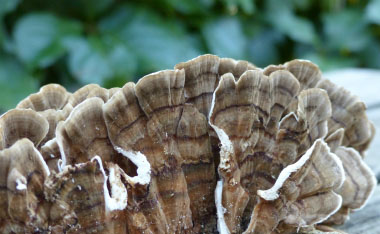
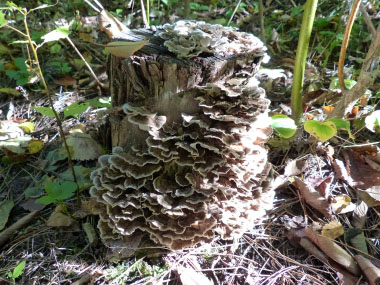
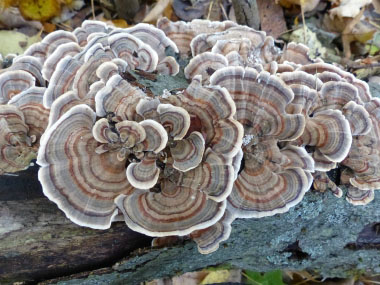
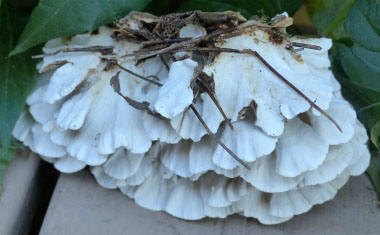
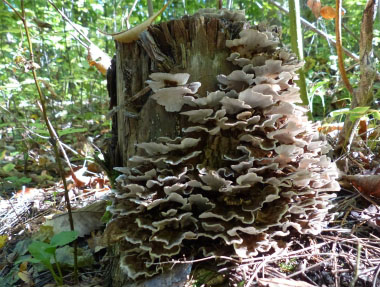
Do not eat any fungi that has not been properly identified by a qualified professional, some are DEADLY when ingested. All edible wild fungi MUST be cooked.
Turkey tails are one of the most common fungi in Canada and throughout the U.S. It is found virtually anywhere there are dead hardwood logs. Its cap colours are quite variable with sharply contrasting concentric zones of colour. They typically grow in rows or overlapping shelves. In Chinese medicine it is referred to as yun zhi, and the Japanese name is kawaratake. This fungi is full of a protein-bound molecule known as PSK, or polysaccharide K. Many polysaccharides (including PSK) have been shown to boost the immune system to fight infection and many different types of cancers.
Type
Distinguishing Features
The cap of a turkey tail measures anywhere between 2 to 10 cm (1 to 4”) across, with an outer edge that may be either smooth and uniform or lobed and wavy. The cap is characterized by defined bands of different colours, which include various shades of cream, grey, yellow, orange and brown. The cap surface is finely fuzzy or velvety. Many turkey tails clearly resemble a miniature turkey’s tail. The white inner flesh is 1 to 2 mm thick and rubbery. The underside is covered in tiny, shallow pores spaced about 3 to 6 pores per millimetre.
Height
Being a bracket fungi it virtually has no height.
Habitat
Turkey tails grows on dead, deciduous wood, in the wounds of living hardwood trees, and on conifers throughout Canada, the U.S., and in many countries worldwide.
Spore Print
The spore surface (and spores) are white.
Season
In the northern hemisphere, turkey tail fruiting season is typically May through December. Although some may persist year-long depending on location and conditions, they are at their best in autumn and winter when they release their spores.
Gills
Turkey tails do not have gills, they have pores.
Edibility
This fungi is not palatable due to its tough texture. When fresh it is best used as a tea. Collecting turkey tails and drying them out is recommended. Once dried they can still be used to make tea, add to other teas, used in soups and in other meals. According to www.midwestmycology.org: "There are, however, no poisonous species of Trametes anywhere in the world, and most have medicinal properties."
Other Name
Coriolus versicolor.
To support our efforts please browse our store (books with medicinal info, etc.).
Winter Survival Food Handbook

PDF Plant Magazines
Types of Wild Food
Geographic Zones Seasons
Disclaimer
EdibleWildFood.com is informational in nature. While we strive to be 100% accurate, it is solely up to the reader to ensure proper plant identification. Some wild plants are poisonous or can have serious adverse health effects.
We are not health professionals, medical doctors, nor are we nutritionists. It is up to the reader to verify nutritional information and health benefits with qualified professionals for all edible plants listed in this web site. Please click here for more information.
Why Edible Wild Food?
- Food costs are rising
- Free, wild food is readily abundant
- Wild food adds nutrition to your diet
- Wild food can help treat various medical conditions





